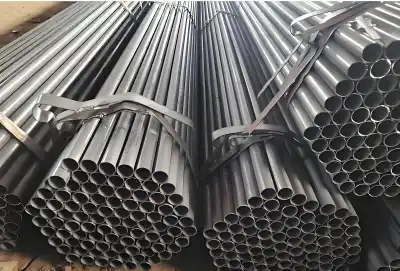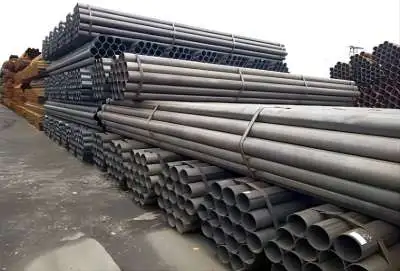In the world of steel pipe manufacturing, the ASTM A135 standard plays a crucial role in ensuring the quality and reliability of pipes used in various applications. One of the key processes in producing these pipes is Electric Resistance Welding (ERW). This article delves into the intricacies of the ERW process in ASTM A135 steel pipe production, its impact on structural integrity, and the advantages it offers over other welding methods.
|
|
|
What is the Electric Resistance Welding (ERW) Process in A135 Pipe Manufacturing?
Electric Resistance Welding (ERW) is a highly efficient and widely used method for manufacturing ASTM A135 steel pipes. This process involves the application of electrical current to join the edges of a rolled steel strip, creating a continuous seam along the length of the pipe. The ERW process for ASTM A135 pipes typically follows these steps:
- Steel Strip Preparation: High-quality steel coils that meet the ASTM A135 standard specifications are selected. These coils are carefully inspected to ensure they meet the required chemical composition and mechanical properties.
- Uncoiling and Edge Milling: The steel coil is unrolled and fed into the production line. The edges of the strip are precisely milled to ensure a clean, uniform surface for welding.
- Forming: The steel strip is gradually formed into a tubular shape using a series of rollers. This process is carefully controlled to maintain the desired pipe diameter and roundness.
- Welding: As the edges of the formed tube come together, they pass between two copper contact wheels. These wheels apply a high-frequency electrical current to the edges, generating intense heat through electrical resistance. The heated edges are then pressed together under significant pressure, creating a forge weld.
- Heat Treatment: Immediately after welding, the weld seam undergoes heat treatment to relieve stress and normalize the microstructure of the welded area.
- Cooling and Sizing: The welded pipe is cooled in a controlled manner and then passed through sizing rolls to achieve the exact dimensions specified by the ASTM A135 standard.
- Quality Control: The finished ASTM A135 pipe undergoes rigorous testing, including hydrostatic pressure tests, non-destructive testing of the weld seam, and dimensional checks to ensure compliance with the standard.
The ERW process for ASTM A135 pipes is characterized by its high production speed, consistency, and ability to produce pipes with uniform wall thickness. This method is particularly suitable for pipes with smaller to medium diameters, which are common in many applications covered by the ASTM A135 standard.
It's worth noting that the ASTM A135 standard specifically covers "Electric-Resistance-Welded Steel Pipe," emphasizing the importance of the ERW process in the production of these pipes. The standard provides detailed requirements for the chemical composition, tensile properties, and testing procedures to ensure the quality and reliability of the finished product.
How Does ERW Affect the Structural Integrity of A135 Steel Pipe?
The Electric Resistance Welding (ERW) process has a significant impact on the structural integrity of ASTM A135 steel pipes. Understanding these effects is crucial for engineers, contractors, and end-users who rely on these pipes for various applications. Let's explore the key ways in which ERW influences the structural characteristics of A135 pipes:
- Weld Seam Strength: One of the primary concerns with any welded pipe is the strength of the weld seam. In high-quality ERW processes used for ASTM A135 pipes, the weld seam can achieve strength equal to or sometimes even greater than the base metal. This is due to the precise control of heat and pressure during welding, followed by appropriate heat treatment. The result is a weld that is fully integrated with the pipe body, providing excellent structural integrity.
- Uniform Wall Thickness: ERW allows for very precise control of wall thickness throughout the pipe, including at the weld seam. This uniformity is crucial for maintaining consistent strength and performance along the entire length of the ASTM A135 pipe. Unlike some other welding methods that may result in thicker areas at the weld, ERW produces a smooth, uniform wall that contributes to overall structural integrity.
- Microstructure at the Weld: The rapid heating and cooling during the ERW process, followed by controlled heat treatment, can result in a fine-grained microstructure at the weld seam. This fine-grain structure often contributes to improved toughness and ductility in the welded area, enhancing the pipe's ability to withstand stress and deformation.
- Residual Stress Management: While all welding processes introduce some level of residual stress, the ERW process, when properly controlled, can minimize these stresses. The immediate heat treatment after welding helps to relieve and redistribute any residual stresses, reducing the risk of stress-related failures in service.
- Corrosion Resistance: The quality of the ERW seam in ASTM A135 pipes can affect corrosion resistance. A properly executed ERW process results in a weld seam that is as corrosion-resistant as the base metal, maintaining the pipe's integrity in corrosive environments.
- Fatigue Performance: The smooth, uniform nature of the ERW seam contributes to good fatigue performance in ASTM A135 pipes. The absence of significant geometric discontinuities at the weld reduces stress concentration points, which are often initiation sites for fatigue cracks.
- Pressure Bearing Capacity: The structural integrity imparted by the ERW process allows ASTM A135 pipes to maintain excellent pressure-bearing capacity. This is crucial for applications where the pipes may be subjected to internal pressure, such as in fire protection systems.
It's important to note that while the ERW process generally enhances the structural integrity of ASTM A135 pipes, the final quality depends on strict adherence to manufacturing standards and quality control procedures. The ASTM A135 standard includes specific requirements for testing and inspection to ensure that the ERW process has been properly executed and that the resulting pipes meet the necessary structural criteria.
For instance, the standard mandates hydrostatic testing to verify the pipe's ability to withstand pressure without leakage or failure. It also requires tension tests to confirm that the pipe, including the weld seam, meets the specified minimum yield strength and tensile strength. These rigorous testing requirements help ensure that the structural integrity of ERW-produced ASTM A135 pipes is consistently maintained.
What are the Benefits of ERW over Seamless or Spiral-Welded Pipes in A135 Applications?
When it comes to selecting the right type of pipe for ASTM A135 applications, Electric Resistance Welded (ERW) pipes offer several distinct advantages over seamless or spiral-welded alternatives. Understanding these benefits can help engineers and project managers make informed decisions for their specific needs. Let's explore the key advantages of ERW pipes in the context of ASTM A135 applications:
- Cost-Effectiveness: ERW pipes are generally more economical to produce than seamless pipes. The manufacturing process is faster and requires less energy, resulting in lower production costs. This cost-effectiveness makes ERW pipes an attractive option for large-scale projects where ASTM A135 compliance is required, such as fire protection systems in commercial buildings.
- Consistent Wall Thickness: ERW pipes typically offer more consistent wall thickness compared to seamless pipes. This uniformity is crucial for maintaining consistent performance along the entire length of the pipe, which is particularly important in ASTM A135 applications where predictable pressure ratings and flow characteristics are essential.
- Superior Surface Finish: ERW pipes often have a smoother surface finish compared to seamless pipes. This smoother surface can lead to better flow characteristics, reduced friction losses, and potentially better corrosion resistance. In ASTM A135 applications, such as fire sprinkler systems, these characteristics can contribute to more efficient and reliable performance.
- Dimensional Accuracy: The ERW process allows for precise control over the pipe's dimensions, including diameter and ovality. This high level of dimensional accuracy is beneficial in applications where tight tolerances are required, ensuring compatibility with standard fittings and ease of installation.
- Versatility in Size Range: ERW pipes can be produced in a wide range of diameters and wall thicknesses, covering most of the size requirements specified in the ASTM A135 standard. This versatility allows for greater flexibility in system design and can simplify inventory management for suppliers and contractors.
- Weld Seam Integrity: While spiral-welded pipes have their place in certain applications, ERW pipes with longitudinal seams often offer superior performance in ASTM A135 uses. The straight longitudinal seam of ERW pipes is generally easier to inspect and provides more consistent properties around the circumference of the pipe.
- Lower Weight: ERW pipes can often be produced with thinner walls compared to seamless pipes while still meeting the strength requirements of ASTM A135. This results in lighter pipes, which can be advantageous in terms of easier handling, transportation, and installation, particularly in retrofit projects where weight considerations are important.
- Uniformity of Properties: The controlled nature of the ERW process tends to produce pipes with more uniform mechanical properties compared to seamless pipes. This consistency is valuable in ASTM A135 applications where predictable performance under various conditions is crucial.
- Suitability for Coating and Lining: The smooth, uniform surface of ERW pipes makes them excellent candidates for various coating and lining processes. This is particularly beneficial in ASTM A135 applications where additional corrosion protection or special surface treatments may be required.
- Quality Control: The ERW process allows for continuous monitoring and control of the welding parameters, enabling manufacturers to maintain consistent quality. Additionally, the weld seam can be easily inspected using non-destructive testing methods, providing assurance of the pipe's integrity.
It's important to note that while ERW pipes offer these advantages, the choice between ERW, seamless, or spiral-welded pipes should always be based on the specific requirements of the project, including pressure ratings, environmental conditions, and any specific regulations or standards that must be met beyond ASTM A135.
For instance, while ERW pipes are excellent for many ASTM A135 applications, there may be situations where the higher pressure ratings or specific properties of seamless pipes are necessary. Similarly, spiral-welded pipes might be preferred for very large diameter applications that fall outside the typical range of ERW manufacturing capabilities.
Contact Longma
In conclusion, the benefits of ERW pipes in ASTM A135 applications are numerous, ranging from cost-effectiveness and consistent quality to versatility and ease of use. These advantages have made ERW pipes a popular choice for many projects requiring compliance with the ASTM A135 standard, particularly in fire protection systems and similar applications where reliability, efficiency, and cost-effectiveness are key considerations.
At Longma Group, one of China's leading ERW/LSAW steel pipe manufacturers since 2003, we're committed to delivering exceptional quality and service. With an annual output exceeding 1,000,000 tons by the end of 2023, we have the capacity to meet the demands of projects of all sizes.
Our ASTM A135 pipe is a prime example of our dedication to excellence. Available in Grade B, it features ERW welding and offers a wide range of outer diameters (1/4" - 20") and thicknesses (SCH10 - SCH160), making it suitable for various applications.
Ready to explore how our solutions can enhance your next project? Contact us today at info@longma-group.com to learn more about our products and services.














